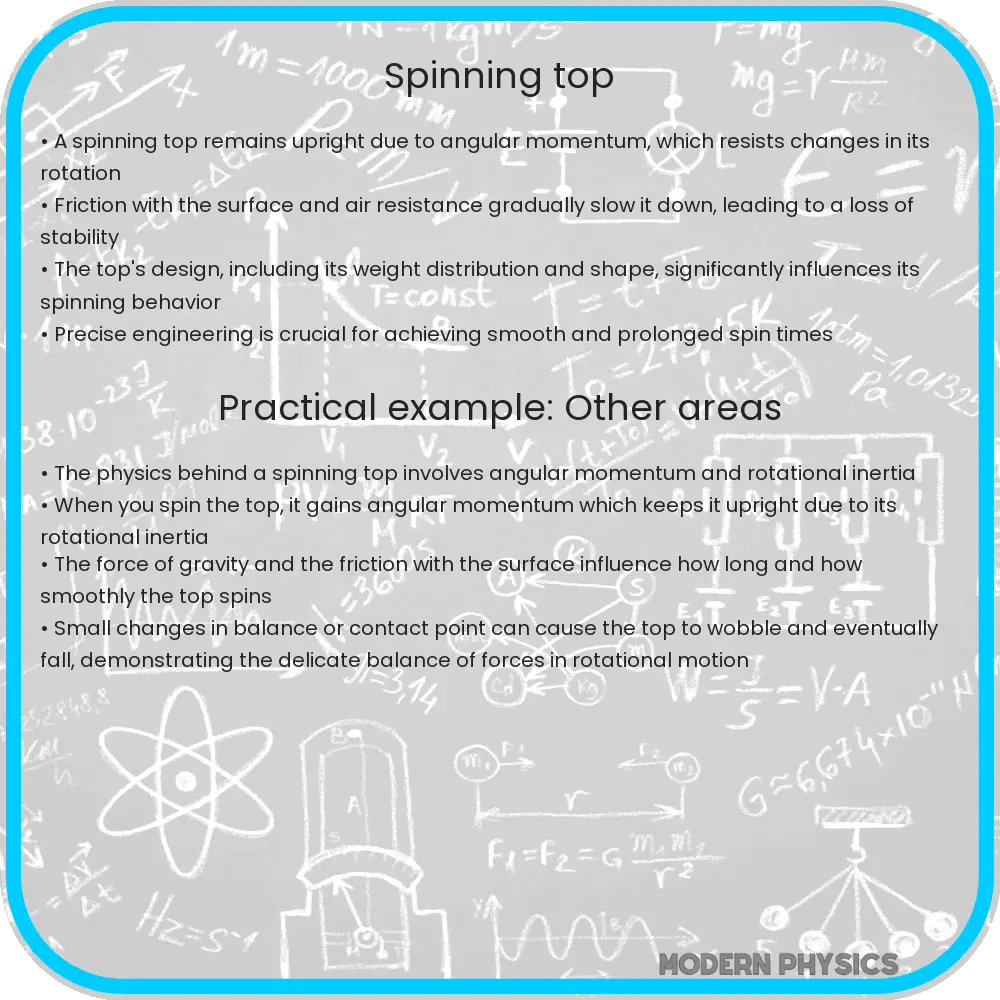Explore the fascinating physics of spinning tops: Understand stability, motion, precession, and the impact of energy and friction in this in-depth guide.

Understanding the Physics of Spinning Tops
The humble spinning top, a toy familiar to cultures worldwide, serves as an intriguing example of physics in action. In this exploration, we delve into the principles of stability, motion, and precession that govern the behavior of spinning tops. These principles not only provide insights into this toy but also reflect broader concepts in physics, applicable to various rotating bodies in the universe.
Stability and Gyroscopic Motion
At the heart of a top’s motion is the concept of angular momentum. When a top spins, it generates angular momentum, which is the rotational equivalent of linear momentum. This momentum, a vector quantity, has both magnitude and direction. The direction of the angular momentum vector is along the axis of rotation, which in the case of a top, is typically vertical when spinning. The angular momentum of a top remains conserved unless acted upon by an external torque, a fundamental principle known as the conservation of angular momentum.
Stability in a spinning top is achieved through gyroscopic effects. When spinning rapidly, a top resists changes to its orientation due to the gyroscopic principle. This resistance is what keeps the top upright, combating the force of gravity that attempts to topple it. The faster the spin, the greater the stability—a phenomenon that can be explained by the increase in angular momentum.
Motion and Precession
Precession is another key aspect of a top’s motion. When a top begins to lose speed and tilt away from its vertical axis, it undergoes precession. This is a slow and gradual rotation of the axis of a spinning object, caused by the gravitational torque acting on the top. The torque, a result of the gravitational force acting at a distance from the rotation axis, induces a change in the direction of the angular momentum vector. This change leads to a circular motion of the axis, known as precession.
The rate of precession is inversely related to the angular velocity of the top. As the top spins slower, the rate of precession increases. This relationship can be mathematically described using the equation: \( \Omega_{\text{p}} = \frac{mgr}{I\omega} \), where \( \Omega_{\text{p}} \) is the precessional angular velocity, \( m \) is the mass of the top, \( g \) is the acceleration due to gravity, \( r \) is the distance from the pivot point to the center of mass, \( I \) is the moment of inertia, and \( \omega \) is the angular velocity of the top.
Understanding these fundamental principles of physics through the lens of a spinning top not only provides a deeper appreciation for this simple toy but also offers a gateway to comprehending more complex rotational dynamics in the physical world.
Energy Considerations and the Role of Friction
Another critical aspect of spinning top physics is the role of energy. The top’s rotational kinetic energy, given by \( \frac{1}{2}I\omega^2 \) (where \( I \) is the moment of inertia and \( \omega \) is the angular velocity), is what sustains its motion. However, this energy gradually dissipates due to frictional forces, primarily at the point of contact with the surface and through air resistance. As the rotational energy decreases, so does the top’s angular velocity, leading to an increased rate of precession and eventual toppling.
Friction plays a dual role in the behavior of spinning tops. Initially, it is necessary for the top to start spinning; without friction, the force applied would not translate effectively into rotational motion. However, as time passes, friction becomes a destabilizing force, gradually slowing down the top and reducing its stability.
Mathematical Modelling and Practical Applications
The dynamics of spinning tops can be described by complex mathematical models that take into account forces, torques, angular momentum, and energy considerations. These models are not only crucial for understanding tops but also have broader applications. The principles governing the motion of tops are analogous to those observed in gyroscopes, used in navigation systems for airplanes and ships, and in stabilizing instruments in space telescopes and satellites.
Moreover, the study of spinning tops and gyroscopic motion has implications in understanding celestial phenomena. Planets, stars, and galaxies exhibit rotational dynamics similar to a spinning top, albeit on a vastly larger scale. The principles of angular momentum conservation and precession help astronomers and physicists understand the behavior of these cosmic bodies.
Conclusion
In summary, the spinning top, a seemingly simple toy, is a window into the complex world of rotational dynamics and physics. Its behavior, governed by the principles of angular momentum, stability, motion, energy, and friction, mirrors that of larger and more complex systems in our universe. The study of spinning tops not only enriches our understanding of fundamental physics but also highlights the interconnectedness of scientific principles across different scales and applications. Through this exploration, we gain a deeper appreciation for the elegance and intricacy of the physical world.
